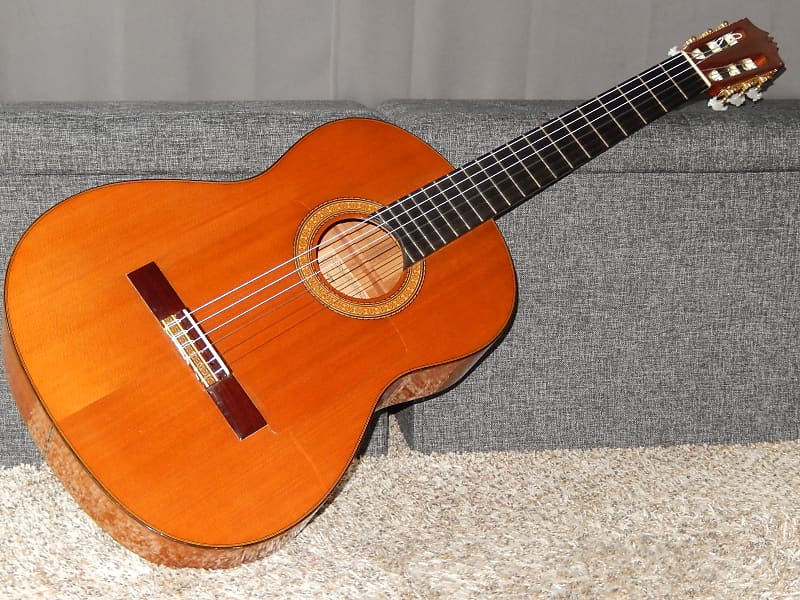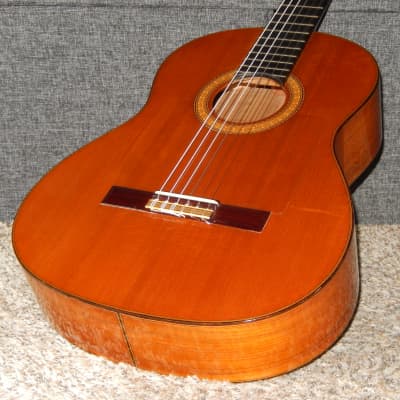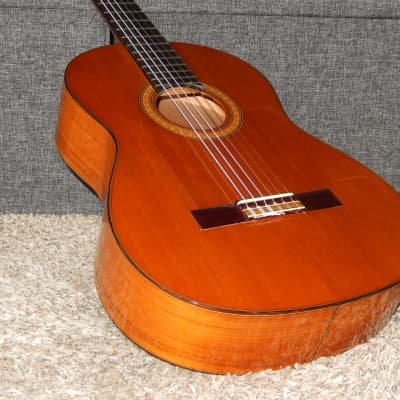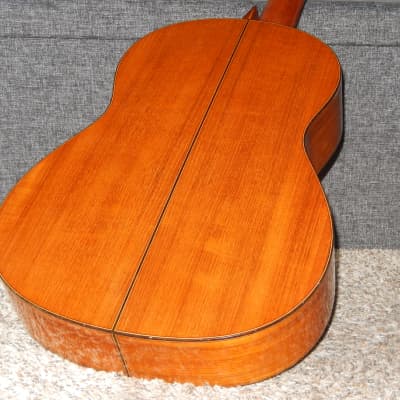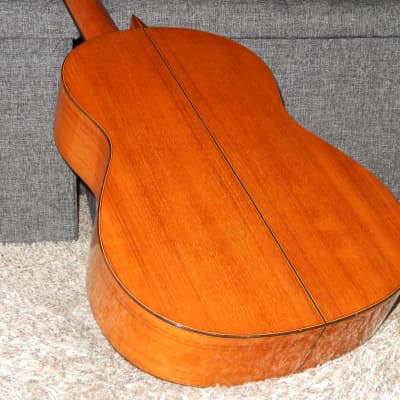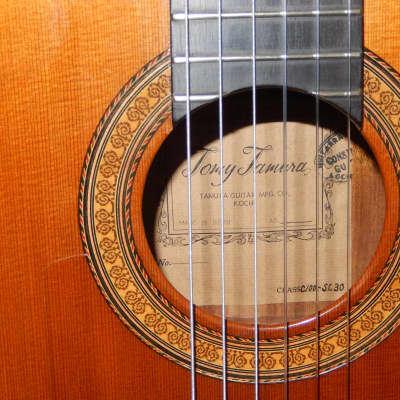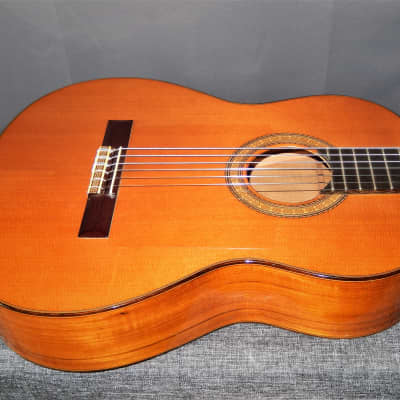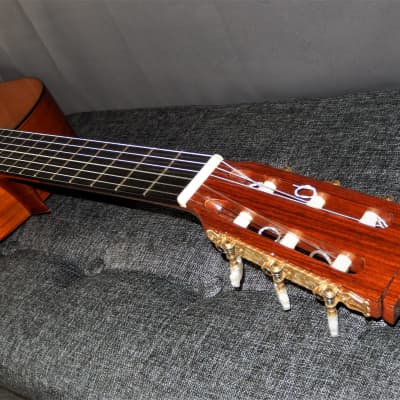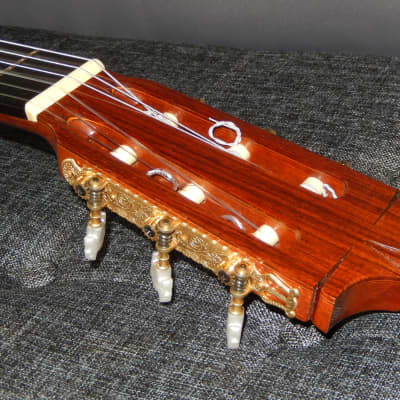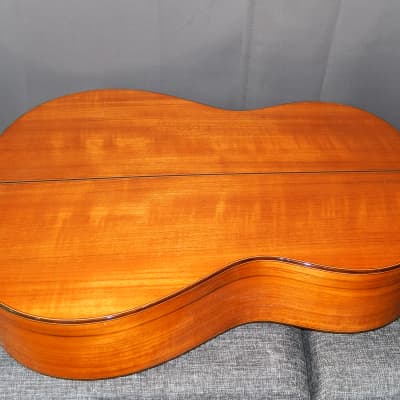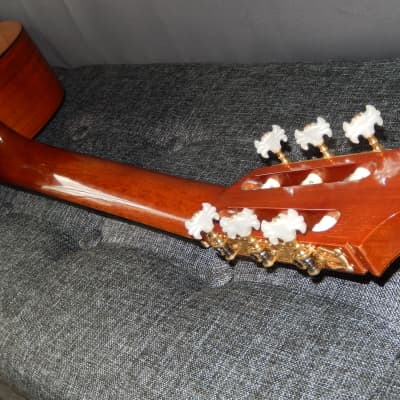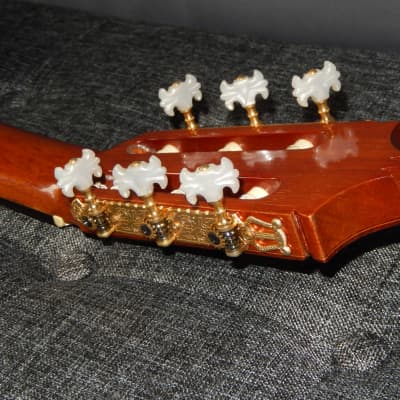Several hundred guitars I have sold in the past are presented at Facebook.com/Victors.Guitar.Library.
Hiroshi “Tomy” Tamura C100-SC30 1977
This guitar was made around 1976/77 by Hiroshi Tamura, one of the best luthiers in Japanese history. Its sound matches the fame of its maker.
Just like many other famous Japanese luthiers of that era, Hiroshi and Mitsuru Tamura have learned their craft during their stay in Spain in late 1950s/early 1960s. After their return from Spain Tamura brothers were making superb quality classical and flamenco guitars that easily challenged guitars made by the most famous Spanish luthiers.
It is quite possible that, during 1960s, both brothers shared the same workshop located in Kochi, Japan. Although both brothers were equally skilled, it was Hiroshi who has gathered more international and domestic rewards. Because his guitars often sounded much better that those made Jose Ramirez, Hiroshi has earned a nickname “Tamirez” As the matter of fact, Hiroshi’s rewards outnumbered those collected by Masaru Kohno.
During mid1960s Hiroshi was giving his guitar models quite heavenly names: Venus, Jupiter, Sirius, Meteor or Comet. Since 1968 his classical models were labelled as P series and flamenco guitars as C series.
In 1972 Hiroshi was financially rewarded by Japanese Ministry of Technology. Soon after, he moved to another shop, but not far from his brother’s, hired several associates and started to make his P and C models in greater numbers, successfully exporting many them outside Japan. Only the very top models Hiroshi was making by himself.
Mitsuru Tamura has continued to work as individual luthier, and with just couple of apprentices, was making about 15-20 guitars a month. As the result Mitsuru’s guitars are harder to find on Japanese second hand market and they often reach higher prices than guitars made by Hiroshi.
Sometime in 1976, after his “factory” started to produce financial losses, Hiroshi had to declare bankruptcy and moved back to smaller workshop, making fewer number of guitar with just couple of helpers.
Both Tamura brothers passed away in mid 1980s. I have seen one Hiroshi's guitar made in 1986 but none made in later years. I believe Mitsuru died couple years earlier. Just like in case of their superb flamenco guitars, classical guitars made by Tamura brothers are equally regarded in Japan.
(Because I have already had very similar instrument with identical label dated to 1977 and model no 100) I am sure that guitar you are looking at was made either in early 1977 or perhaps in late 1976. It was the time Hiroshi when was trying to reorganize his business after declaring bankruptcy a year earlier. He was now working on new model designs and lineups, experimenting with new headstock designs, new rosettes, new label designs and nick names like “Tomy Tamura” or “Fumio Tamura”. Since early 1978 he was using yet another design label (which he kept unchanged till the end) and his models were no longer P or C series.
Being priced 100 000 yen in 1977 this was quite expensive instrument (certainly not only to Japanese players).
Most likely the only higher flamenco model of that era was C150. Perhaps Hiroshi has also made some higher priced custom made guitars. All these higher end models were made with different tops and different scales and certainly in limited numbers. They very rarely appear on Japanese second hand market. Abbreviation “SC” means Cedar top and Cypress b/s.
This guitar plays easy and sounds fantastic. It is very light and highly responsive instrument. Its tonality can be described as between traditional and modern era high end flamencos. Even though it was made with cedar soundboard this guitar sounds different from many other Cedar top flamencos I have ever encountered. There is nothing “nasal” about its sound. When played gently it sounds sweet and lyrical and you can play any romantic piece that you can imagine. When played harder it produces raspy flamenco sound at very good volume, with relatively deep, somewhat metallic basses and brilliantly crisp trebles. All notes are well balanced, with moderately long flamenco style sustain. When the chords are played one can hear a good bit of wonderful overtones. Perhaps the most important (to experienced players) attribute of this guitar is its exceptionally high level of note clarity and separation, which leads to great level of transparency when it comes to playing arpeggios and solos.
If you primarily looking for a loud instrument just to accompany a dancer, you should be looking for a different one. If you however believe in reaching for Paco de Lucia level, you should be very interested in this C100 guitar
Even though its body bears few very small and light dents overall condition of this guitar can be described as “at least very good for its age”. Its woods are very well preserved without any conspicuous scratches or cracks, neck is straight, fingerboard and leveled frets remain in very good condition, and importantly neck/body angle allows for very low action.
This action is currently set to 2.50mm under E6 and 2.20mm under E1 just because it was possible. This action means exceptional ease of playing but also occasional buzzes and/or “clicks” along trebles (especially when strings are played harder). The truth is that many professional players favor higher action. If you prefer higher action you will need to invest in higher saddle.
Specifications:
Top: Solid Cedar/5 braces fan/cashew lacquer
Back & Sides: Solid Japanese Cypress/cashew lacquer
Neck: Mahogany
Fingerboard: Ebony
Bridge: Rosewood
Scale: 664mm
Nut width: 51mm
Hardware: Gold plated Gotoh tuners with 39mm peg roller spacing
Action is set to 2.50 mm under E6 and 2.20 mm under E1, with still extra room on the saddle.
Guitar will be shipped in lightly used very thick padded (semi-hard) case.
The key to understand value of vintage Japanese guitars is to acknowledge galloping price inflation (devaluation of Japanese yen) during 1960s & 1970s. This inflation slowed down in 1980s.
During 1960s and most of 1970s model numbers of Japanese guitars were strictly interconnected with their prices in Japanese yen. By early 1980s and during following decades model numbers were no longer strictly associated with their prices. Some Japanese guitar makers introduced model names instead of model numbers. Others were still using model numbers with addition of letters and/or other symbols.
It is then important to understand that two Yamaha GC10 guitars made 10 years apart are two instruments of totally different class. The same applies to any other Japanese maker/brand.
The logical way to estimate the true class of any given Japanese made instrument is to compare its price with the average annual salary of wage workers in Japanese private sectors. This salary was: 450 600 yen in 1965 - 825 900 yen in 1970 - 1 868 300 yen in 1975 - 2 689 000 yen in 1980 - 3 163 000 yen in 1985 - 3 761 000 yen in 1990 - 4 107 000 yen in 1995 - 4 082 000 yen in 2000.
Any guitar priced 100 000 yen in 1970 (labelled as No10 or No100) would be priced 200 000 yen in 1975 (relabeled to No20, No200 or 2000), 300 000 yen in 1977 (labelled as No3, No30 or 3000) and 500 000 yen by 1985 (labelled as No50 or 5000).
Starting in 1977 Masaru Kohno introduced his new models No40 priced 400 000 yen and No50 priced 500 000 yen. By early 1980s Kohno started using model names instead of numbers and was steadily raising their prices without changing model labeling. His very top model 50 became model “Special”, and a decade later it became model “Maestro”. Naturally, all other Japanese guitar makers were doing similar pricing (labelling) upgrades.
Knowing all of that, you can bet on that Masaru Kohno No50 made in 1982 is practically the same grade instrument as Kohno No20 made in 1972, or Kohno no 30 made in 1975.
In early 1970s the lowest Ryoji Matsuoka (all plywood) model was 10, followed by (solid top) models 15, 20, 25, 30, 40, 50, 60, 80 and (all solid woods) models 100 and 150. Models 50, 60 and 80 were made with non-solid figured Brazilian Rosewood (double) back and sides and top model 150 was the only one made with solid figured Brazilian Rosewood b/s.
In 1980 the lowest Matsuoka model was (all plywood) 20, followed by (solid top) models 30,40,50, 60 and all solid woods models 80,100,150 and 200. By 1990 the lowest Matsuoka model was M40 and the highest was M300. By 2010 the lowest Matsuoka model was M50 and the top model was M270.
You can bet that Ryoji Matsuoka model 50 from 1980 is of the same grade as model M100 from 2000, model 100 from 1980 is of the same grade as model M150 from 2000, model 150 from 1980 is of the same grade as M200 from 2000 and model 200 from 1980 is of the same grade as model M300 from 2000.
It is important to mention that if modern era luthiers are using 40+ years old woods to make an “all solid” wood classical guitar, its price is minimum $8000.
All vintage guitars made with Brazilian Rosewood are especially precious, including those made straight grain varieties and those with non-solid b/s.
Because response and tonal properties of Spruce soundboards are improving over time, long seasoned Spruces are far more precious than long seasoned Cedars.
It is not very difficult to find out what are current prices of such guitars made by world’s leading luthiers.
Important message for Australian buyers:
USPS International Priority Mail packages destined for Australia have quite restricted size (max. length is 42” and max. length + girth is 97”). For these reasons I must use the case that is no longer than 41” and therefore it may be different than the one you see on the pictures. You should ask me for any other details prior to making a purchase.
